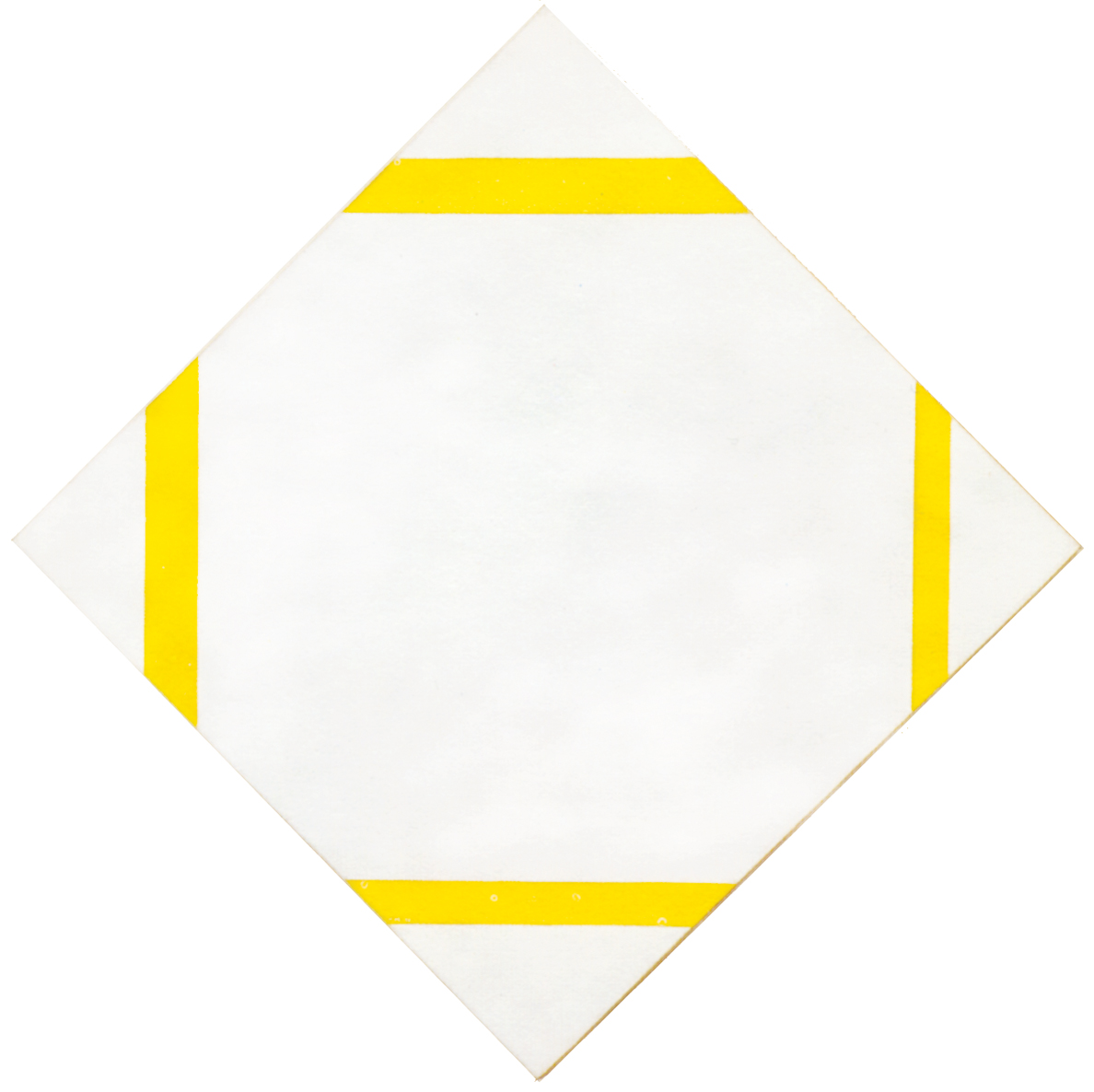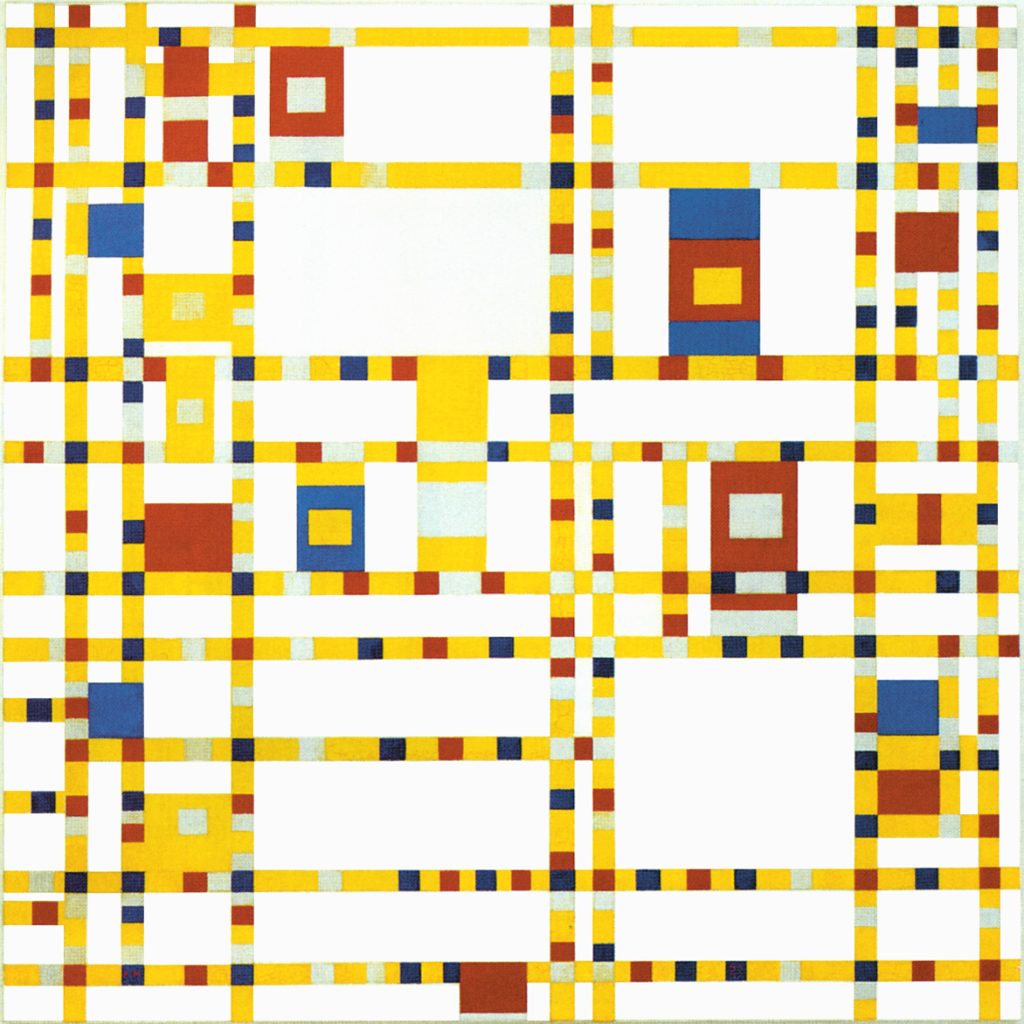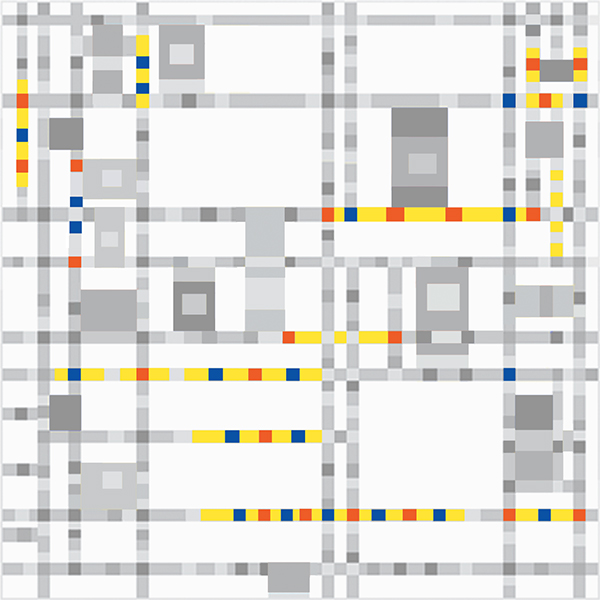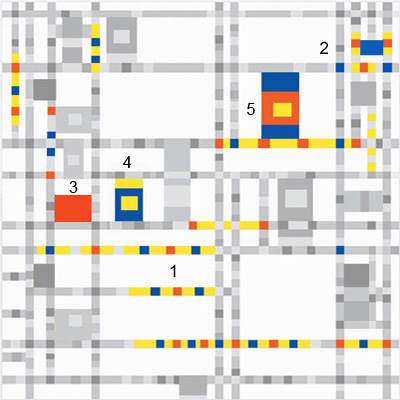I have often spoken in my explanation of Mondrian’s oeuvre about multiplicity and unity, infinite and finite, variable and constant, suggesting possible analogies between Neoplastic space and existential reality. I shall now develop this aspect in greater depth. Some aspects have already been alluded to in the pages examining the artist’s works from the earliest of the naturalist period to the last two abstract masterpieces.
If we see Broadway Boogie Woogie (BBW from now on) as a two-dimensional representation of our inner space, we can interpret the opposing lines, the multiplicity of flashing impulses within the lines and the multifaceted planes of different size, proportions and colors as symbolizing the rich and contradictory reality existing within us. Ours is the sometimes difficult task of understanding the sense of the conflict and opposition and finding a a synthesis between opposites (evoked in BBW by the unitary plane) capable of endowing our actions with a sense corresponding to our true nature.
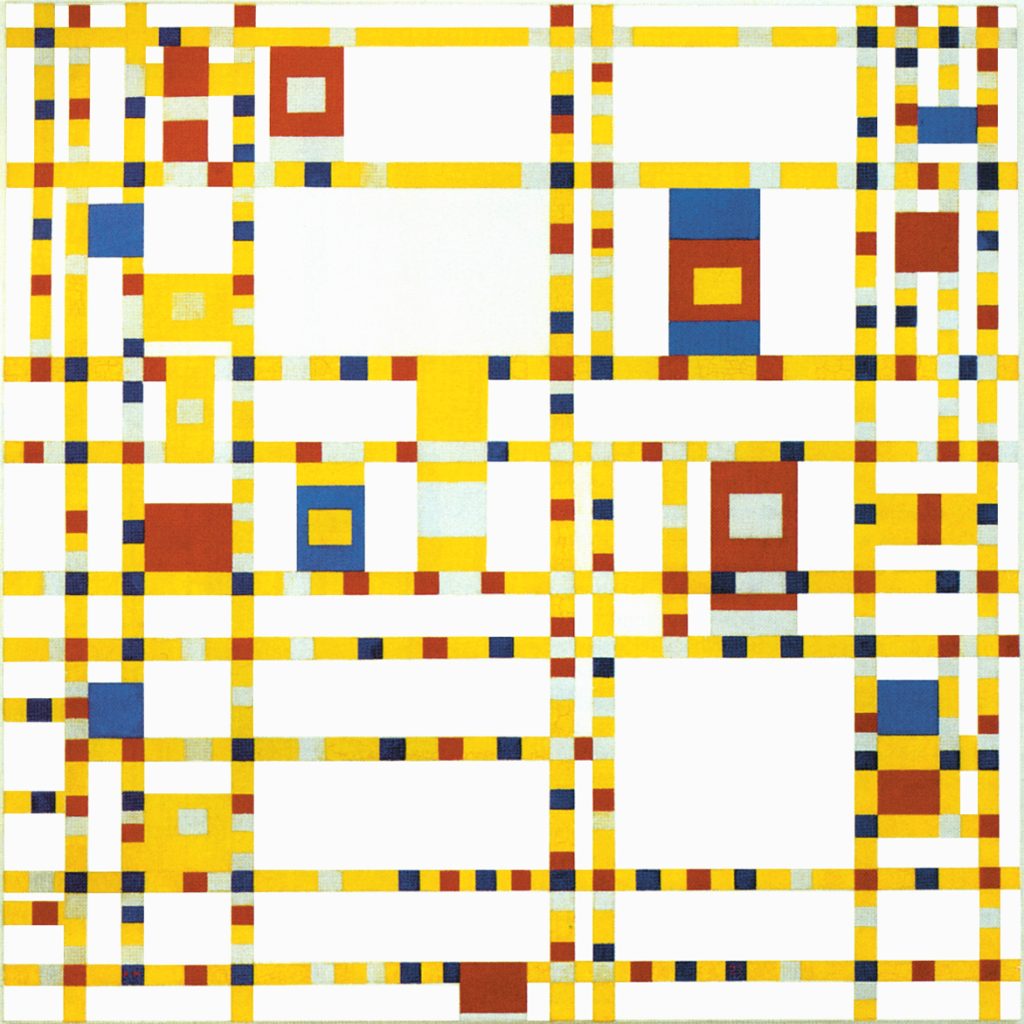
1942-43
We should be aware of our own being. Diversity and contrast should not, however, prevail and invade the self; the many must not prevail over the one, but still less can the self avoid confrontation with the contradictory multiplicity we consist of. Discover to our deep sorrow that external conflict is often born out of unresolved tension within us.
Overcome the self through the self
We can regard the transition from the frenetic and precarious space of the small squares within virtually endless lines to the contained and more constant space of the planes (from an external to an internal space) as a plastic symbol of the gradual consolidation of an inner being through resistance to the conflicting pressures of the external world (the opposing lines) and reinforcement of the equilibrium within (synthesis and the equivalence of opposites).
Every small square has one part of itself (horizontal) that is opposed to the other (vertical). Every line strives to open up the concentration that every plane endeavors in its own way to consolidate and preserve. This generates a dialectical process of evolution. In this perspective, the straight lines are a symbol of the “temptations” with which external reality continually solicits our inner integrity.
Indian wisdom says that “the self is the friend of the self for those who overcome the self through the self”. Those who resist initial impulses and overcome situations of duality transform conflict with the self into synthesis and unity of being. At the same time, however, the process of growth and enrichment would not be possible without conflict and opposition.
Will power makes it possible to resist the promptings of instinct and keep the inner space comparatively whole, but there would be no evolution and progress without the discordant pressures that put us to the test and thus afford the opportunity for self-consolidation. Will power with unity as its aim would be nothing without the temptations that seek to weaken it (the single straight line that runs contrary and threatens equilibrium and the synthesis of opposites). It is up to us to derive benefit and enrichment from temptation without yielding, to open up to the world without getting lost in it. I am thinking of Mondrian’s oeuvre and the process of opening up and interpenetration established between unity and multiplicity. It is essentially a question of measure and proportion.
Neoplastic space tells us that the excessive predominance of any part of us will sooner or later generate an opposite reaction. The dynamic equivalence of opposites: multiplicity tends toward unity and unity generates new multiplicity. In BBW, as in life, excess generates its opposite. A traveler who keeps heading east will eventually arrive in the west. This is how things seem to work on this planet. This is how the space of BBW works. We are reminded of Dante Alighieri and his law of divine retribution.
Balancing duality
The meeting of two perpendicular lines gives birth in BBW to small squares (Diagram A). These can be seen as parts of one line inside the other:
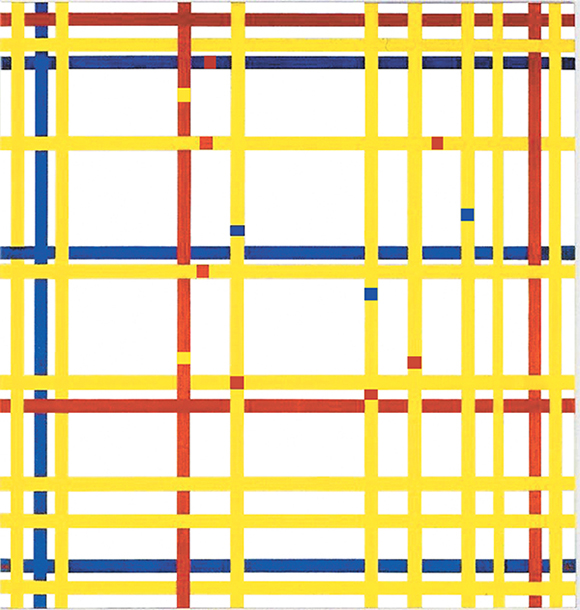

1942-43
The relationship between the straight lines and the small squares is one of interaction between a space of infinite extension and of exclusively horizontal or exclusively vertical nature ont he one hand and a finite space (the small square) that seeks instead to concentrate and maintain equilibrium between the two opposing directions on the other.
Mankind also lives in a condition of inner duality in a constant dialectic between instincts and intellect; between the Natural and the Spiritual as Mondrian put it. The human being experiences a finite dimension in relation to the infinite space of the universe in much the same way as the finite space of the small squares within the virtually infinite space of the lines in a two-dimensional space.
Disorder / Order
The small squares strive to concentrate space upon itself so as to maintain balance between the two opposing directions, each of which would seek to expand the same space exclusively in one way. The tendency of the small square to restrain and counterbalance the dynamic and disordered space of the lines manifests itself in symmetrical configurations (diagram B):
A symmetry is to be understood here as a measurable and hence finite interval of space generated within the infinite space of a line, a more orderly and constant section within a variable space. Human beings also endeavor during their lives to transform the variable flow of existence as far as possible into a more orderly and constant rhythm of foreseeable events.
We humans feel the desire to reduce and control the change that life brings with it, striving to consolidate the flow of our actions and give them concrete shape in artifacts demonstrating that the flux of time has been transformed into something of a comparatively more permanent nature.
Works, ideas, children: elements able to give meaning and a sense of greater permanence to our passage through life. Can we not see a visual symbol of this in the chaotic multitude of small squares that come to form more solid entities? (Diagram C 1, 2, 3, 4, 5)
Exterior / Interior
The locating of a small square on a horizontal or a vertical line generates opposition respectively with its own vertical or horizontal component. The small squares move back and forth between the horizontal and vertical lines so as to rectify every instance of momentary imbalance.
It often occurs in our lives that internal imbalance generates external movement (action) and the attainment of a new internal equilibrium is then challenged by a new external situation in a constant dialectic between interior and exterior.
In BBW the never ending external space of the straight lines is internalized into planes (Diagram B) and internal space is then externalized (Diagram C).
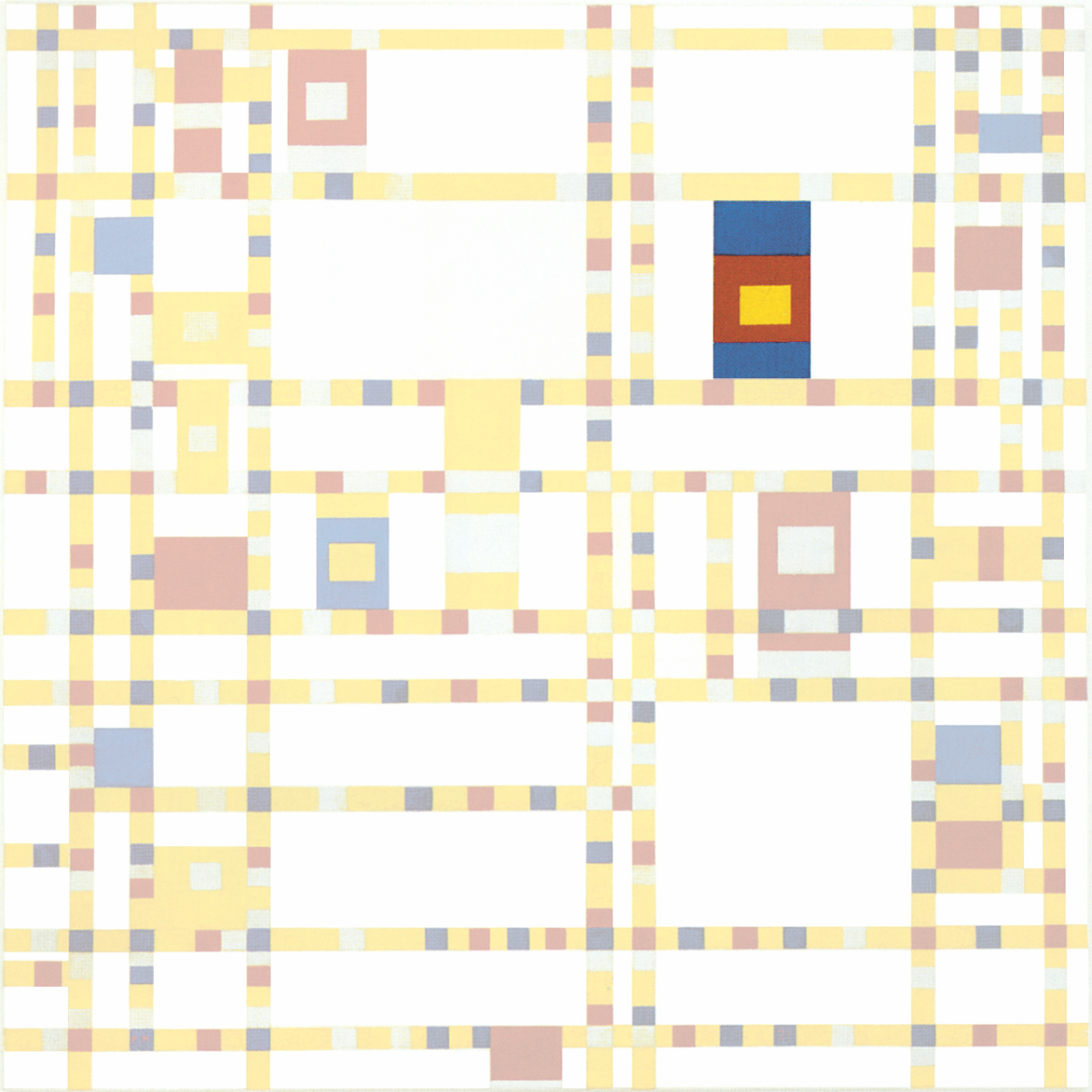
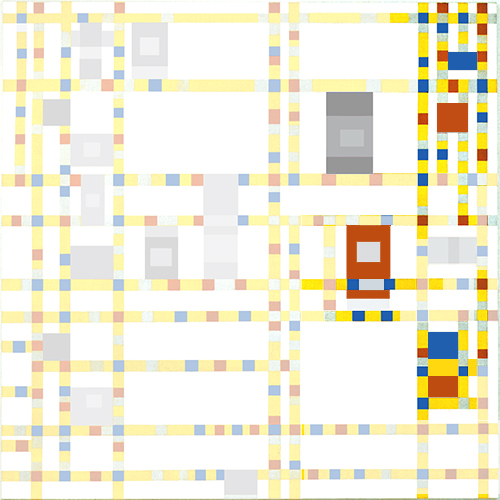
We have already observed this dialectic between exterior and interior in the Evolution triptych of 1911.
Internalizing the exterior means opening up, going beyond the narrow boundaries of the conscious self, and allowing this to be enriched as far as possible by the unpredictable diversity of the world, not only the external world but also the internal, the almost infinite reality that we bear within us and often find it difficult to decipher. It means taking cognizance of the duality existing within us; understanding that our every act (thought or action) is the result of opposing drives, just as every small square or plane of BBW is born out of impulses that unavoidably undergo a vertical shift while intent on developing horizontally and vice versa.
The equilibrium attained between exterior and interior is never static. Neoplastic space is therefore grounded on a dynamic relationship between opposing entities. This is why unity (Diagram D) opens up again to the external multiplicity (diagram E). These are moments of equilibrium attained, lost, and then regained in a new form. The greater the effort to establish an equilibrium in a stable and absolute form, the more it opens up to a new movement making it unstable and relative. So it is in our lives.
The immediacy of the painted image is certainly very different from the much longer and more intricate processes of real life. Neoplastic space expresses the instantaneous life of the moment while simultaneously evoking processes that can last a long time in reality and ultimately suggesting the unity of all things, i.e. a dimension that we associate with the eternal. BBW is to be seen as a concentrate of space and time: what lasts the length of time required for perception of the visual fact in the representational dimension of art can instead dilate and last for days, months, and years in the space-time of real life.
The thousands of different situations that orchestrate the rhythms of our existence are condensed in the work of art that represents life in essential and hence abstract terms. If it were not abstract, if it were concerned with the fleeting aspects of each individual situation and thing, it would lose sight of the whole and be unable to express life at a universal level.
The entire process observed in BBW can be summarized as an expanded space undergoing gradual concentration. In this light, we can regard the unitary plane and the entire painting respectively as synthetic and analytic or as complex versions of one and the same thing. I am thinking once again of the flower that looks like a condensed point when seen from a distance but reveals increasing complexity on closer observation. In addition to the external landscape, however, I am thinking also and above all of its internal counterpart made up of varied and contradictory signs that sometimes display a certain continuity and become like pieces of a jigsaw puzzle, ultimately revealing a single overall design.
Social life
The relationship between what changes and what maintains greater constancy regards not only individual but also social life. Ethics, laws, institutions are tools that mankind uses to govern the relations between individuals and their interaction with the environment.
The process observed in BBW shows loose gray, yellow, red and blue fragments becoming more solid and permanent planes which finally transform into one large plane unifying all colors (Diagram D):

In abstract form the composition tells us that life is change (the mutable small fragments) but if people are to live, they need to reduce and stabilize the ever-changing flux of existence (from small squares to larger planes up to the unitary plane).
As Mondrian put it, “It is important to distinguish two types of equilibrium in art: 1) static equilibrium and 2) dynamic equilibrium. It is always natural for human beings to seek static equilibrium. This equilibrium is obviously necessary for existence in time. But vitality always destroys this equilibrium in constant temporal succession. Abstract art is a concrete expression of this vitality.”
At the same time the paintings shows that, after reaching a more stable situation (Diagram D), the unitary plane opens up again to the unstable multiplicity of the small fragments (Diagram E):


This means that every attempt to reach a stable condition is always jeopardized by the vitality of life. “..vitality always destroys this equilibrium in constant temporal succession” (Mondrian)
The lines, which express the maximum degree of energy and do not stop continuing, represent vitality. The symmetrical sequences and the larger planes, which express a measured space and are endowed with greater permanence, albeit not total immobility, represent the equilibrium required for existence in time.
Interpreting the geometry of the painting in terms of social life, in this dialectic between what persists and what changes, crucial importance will attach to establishing rules, laws, and institutions capable of remaining open to the evolution that existence brings with it and hence of performing their regulatory function without stifling vital demands any more than necessary.
“Today we need to have the courage to take up the discourse on the essentials, the core values and the ends, in order to adapt behavior and structures to growth. This is the task to which our generation is called. We must fulfill it in social life, in ecclesial life, in religious life.”
B. Sorge, Il futuro della vita religiosa, Roma, Rogate, 1979 pp. 12
When laws and institutions oppose the movement and transformations that life brings with it, all they do is generate greater unrest over time, which in turn generates greater resistance on the part of the institutions and so on in an exhausting vicious circle where it is ultimately life that prevails and not our “symmetrical” stubbornness. This is what human history teaches. This is what is shown by the geometry of Broadway Boogie Woogie, where space arrives at a certain degree of control and then opens up again to an unforeseeable becoming.
In social life too, greater importance now attaches than ever before to the ability to handle the relationship between the one and the many, moving constantly back and forth between the parts and the whole so as to avoid the predominance of either the multitude of particular interests or the will of the few. The former brings chaos and makes it impossible to work for the common interest; the latter brings the paralysis of democracy if not indeed oligarchy and dictatorship.
In a world that is being brought together through the process of globalization, it is essential to devise flexible systems where the general (the tendency toward synthesis) is in close contact with the particular (multiplicity) and the two terms are wholly interdependent. This is precisely what Mondrian endeavored to express with the constant dialectic between unity and multiplicity right up to his two last works (Broadway Boogie Woogie and Victory Boogie Woogie), where unity coincides with multiplicity.
Would the fusion of unity and multiplicity at the social level perhaps mean achieving more effective political representation, manage the life of the polis in real time? This point would merit consideration in greater depth.
Our soul
When we are born on this planet as individuals, we partake of an infinitesimal portion of cosmic energy that we must learn to manage, preserve, and consolidate in a more constant structure that we then return to the cosmos when our bodies dissolve. We are responsible for our soul, which is not wholly ours in actual fact. The process observed in Broadway Boogie Woogie strikes me as representing this cycle. The ephemeral (the small squares) attain greater solidity and duration with the largest plane (Diagram D) before returning to the fleeting multiplicity of small squares (Diagram E):


back to reflections
Copyright 1989 – 2025 Michael (Michele) Sciam All Rights Reserved More
